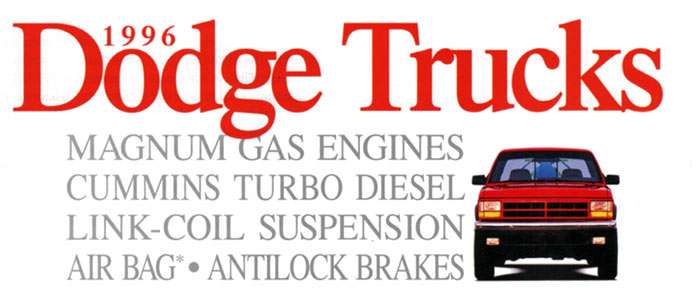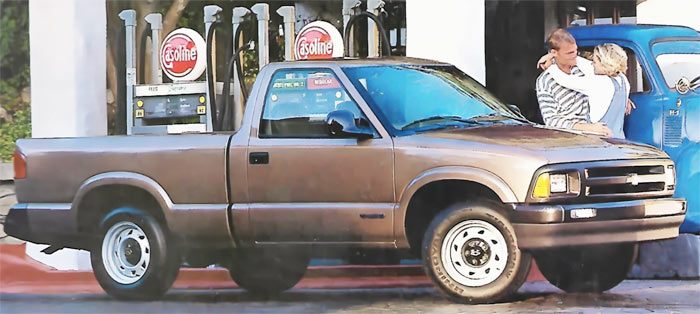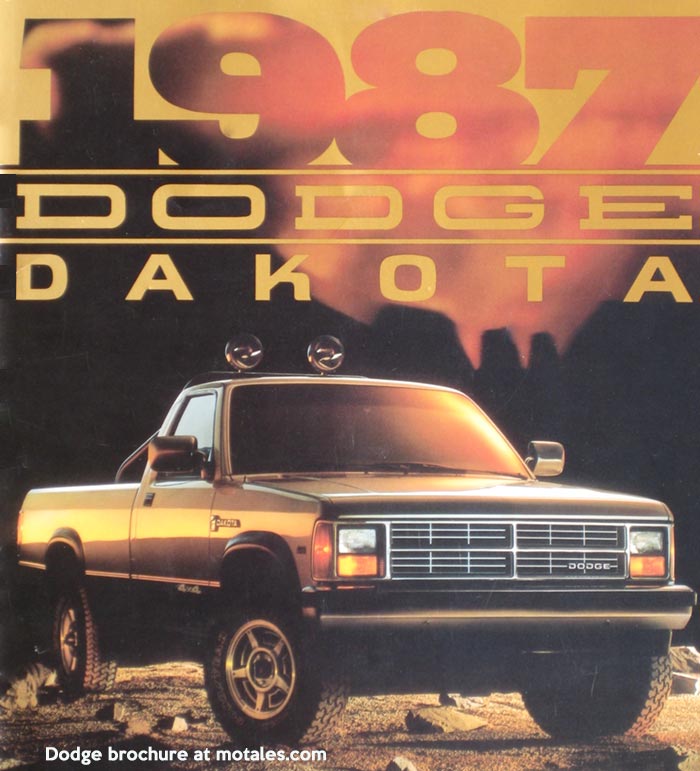
Compact and midsize pickups were still quite popular in the mid-1990s—and also still reasonably compact, other than the Dodge Dakota. The class was not yet almost entirely dominated by the Toyota Tacoma, and the long-familiar Ford Ranger, which was to be dropped and then make a splashy comeback much later, was still, with the Chevy S-10, a staple of American truck production. Oddly, Dodge had not made a compact pickup of its own since dropping the A-series at the end of 1970; they had resold Mitsubishis instead. The Dodge Dakota, mainly engineered by a contractor, sat between compact and full-size; it was about the size of an International Harvester Scout, yet not much heavier than the Ranger or S-10. This was the 1996 Dodge Dakota—one year from being replaced with a far better pickup, yet still competitive.
| Base model | Chevy | Ford | Dodge |
|---|---|---|---|
| Cab and bed | Single, short | Single, short | Single, short |
| Max payload | 1654 | 1650 | 2600 |
| Curb weight | 2822 | 2907 | 2997 |
| Length | 189 | 184.3 | 195.3 |
| Ground clearance | 7.2 | 6.6 | 6.8 |
| Leg room | 42.4 | 42.4 | 41.6 |
| Bed length | 72.6 | 72.2 | 78.1 |
| Optional bed | 88.6 | 84.2 | 96.6 |
| Bed width (min) | 40.3 | 40.4 | 45.0 |
| Bed width (max) | 56.5 | 51.2 | 59.6 |
The typical 1996 compact pickup started at around $10,000, with a torque-tuned four-cylinder engine, five-speed manual transmission, and driver’s side airbag; options were longer beds, four-speed automatic transmissions, four wheel drive (shift-on-the-fly), a V6 engine, and a bewildering array of options with various axle ratios, suspensions, and such. The base models had a single row of seats and two doors, with extended cab models. They had optional off-road packages which stiffened the ride to the point of discomfort, and the 4x4 setups usually raised their height quite a bit.
The Chevrolet S-10 had been redesigned in 1994, giving it a more comfortable cab and ride, with better reliability. GM, at that point, had daytime running lights consisting of the high beams at far too high a brightness. Chevy loaned me one of these for a week, an LS trim level (a mid-tier trim) with some options that bumped the price from $9,655 to $13,700; it had the base 118 hp 2.2 liter engine, which, coupled with the smooth five-speed manual transmission, seemed to be more than enough given 130 lb-ft of torque. With the four-cylinder it could tow up to 4,500 pounds; with the V6 , up to 5,500 (actual tow ratings depended on equipment and axle ratios).

As with most torque-heavy small engines (like the Chrysler 2.5), it started out quite fast but then ran out of breath, so stoplight acceleration was easy but merging onto I-95 or I-80 might not be, and passing on the highway took a downshift. Gas mileage was rated at 23 city, 29 highway, which was quite good, but the tow rating was just 2,000 lb; the 191 hp V6 increased the maximum towing, when properly equipped, to 6,000 lb. (The V6 easily outpowered the Ford Ranger in horsepower and torque—30 hp, 40 lb-ft higher.)
I was surprised by the Chevy’s handling, ride, and quiet interior (for the times), and impressed by the layout, including the between-the-seats cargo compartment and multipart sun visors. I was also, as usual, dismayed by GM’s insistence on using brights for DRLs, the weird all-in-one heavy stalk, and the annoying warning buzzer. There were no squeaks and rattles. Overall, the S-10 was a far, far better pickup, in my personal experience, than the Ford Ranger.
There was another version of the S-10, an SUV called the S-10 Blazer, which later became just plain Chevy Blazer. The S-10, as a best seller, could and did have many options packages for various levels of capability and “sportiness.” Seven wheels were available in the 1997s, for example. There were four different LS preferred equipment packages. For 1997, at least, buyers did only have the two engine options shown here.
Ford’s market research had shown that most people bought pickups because they looked cool, so my test truck was the new “Splash” trim, which did not last long. It had a passenger-side panel that looked like an airbag cover but wasn’t, and faux exterior styling. The interior was nice overall, like the Chevy with quite good sun visors, a well designed instrument panel, and a good center console. It seemed like the lap of luxury until the key was turned and we encountered an engine that idled so roughly, it was hard to believe it was a fuel injected V6 and not a carbureted four in rough shape. Immediately on shifting to Drive, squeaks, creaks, and rattles came from every part of the (new) pickup.

Power was surprisingly good given the moderate ratings. The off-road suspension, which may have been the cause of the cacophony of interior noise, felt as though shock absorbers and springs had been swapped with steel rods. The base models were definitely smoother. Handling was another problem, with the overly stiff suspension causing ironic loss of traction at any encounter with road dirt. The narrow cargo box of the Splash was a triumph of fashion over function.
The Dakota was not by any means a compact pickup, but it was smaller than a full size Dodge D-150. Needless to say it had a bigger bed and higher payload, and was available with the only V8 of these three. For the first time it had the AMC/Jeep four-cylinder, a 2.5 liter with multiple port fuel injection confusingly replacing the old throttle-body 2.5—one engineered by AMC, the other by Chrysler, sharing nothing. This had 120 hp and 145 lb-ft, more than the Chevy or Ford base engines, but also with lower fuel economy. The 1995 Dakota had the less efficient, less powerful Chrysler version with 99 hp and 132 lb-ft of torque.
| Engines | Chevy 2.2 | Ford 2.3 | Dodge 2.5 |
|---|---|---|---|
| Power | 118 | 112 | 120 |
| Torque | 130 | 135 | 145 |
| Curb weight | 2822 | 2907 | 2997 |
| MPG | 23/30 | 22/27 | 21/25 |
| Max tow | 2,000 | 2,300 | 2,500 |
| Engines | Chevy 4.3 | Ford 4.0* | Dodge 3.9* |
| Type | V6 | V6 | V6 |
| Power | 191 | 160 | 175 |
| Torque | 260 | 220 | 225 |
| MPG | 20/24 | 18/23 | 16/22 |
| Max tow | 6,000 | 6,000 | n/a |
* A Dakota V8, the 5.2, topped the range with 220 hp, 295 lb-ft of torque, 14/18 mpg, 6800 lb max towing. Ford also had a 3.0 V6 with 19 city, 25 highway mileage. All gas mileage quotes are for the base model with that engine, with the five speed transmission if available.
I never drove the Dakota in that era. I was quite impressed by the 1997 version, though. Consumer Reports hated it, but they generally disliked Chrysler products in those days, aside from grudging respect for the Ram 1500 and some minivans, depending on the year; they also paid intense attention to four-speed Chrysler automatic failures and ignored similar failures at Ford and Honda. Given they also hated the 1997 Dakota, which just about everyone else thought was top of class with a surprisingly good ride and fine handling, their opinions can be discounted.
| Dakota RWD | Dakota 4x4 | Club Cab RWD | Club Cab 4x4 | |
|---|---|---|---|---|
| GVWR | 4,390-6,150 | 5,250-5,870 | 5,100-5,650 | 5,450-5,830 |
| Payload | 1,250-2,600 | 1,450-2,000 | 1,450-2,000 | 1,450-1,800 |
| Wheelbase | 112 or 124 | 112 or 124 | 131 | 131 |
| Box (Ft) | 6.5 or 8 | 6.5 or 8 | 6.5 | 6.5 |
| Base engine | 2.5 four | 3.9 V6 | 3.9 V6 | 3.9 V6 |
| Opt. engines | V6, V8 | V8 | V8 | V8 |
| Turning dia. | 39.8 / 43.5 | 39.8 / 43.5 | 38.5 / 42.1 | 46.6 |
| Base trans. | 5-spd man | NV231 | 225 | |
| MPG | 20/24 | 18/23 | 16/22 | |
| Max tow | 6,000 | 6,000 | n/a |
Every Dakota had 10.9 x 0.94 front disc brakes and 9 x 2.5 rear disc brakes. The clutch was 9.0 inches on the rear drive models and 10.5 inches on 4x4s. Four wheel drive came through a New Venture Gear NV231 two-speed transfer case. Every configuration had a base five-speed manual transmission with an optional four-speed automatic.
On the other hand, the Dakota was the oldest design in this group, having been launched in 1986. It was claimed to be America’s first midsized pickup, and originally had a 2.2 liter base engine and the 3.9 V6 hurriedly derived from the 318 V8. With an automatic, the odd timing of the 3.9 was no problem, but it was not especially pleasant with a manual transmission—or so I’ve been told!

Dodge did sell quite a few Dakotas (111,677 in 1995, 104,754 in 1996, with capacity constrained as the factory shut down midyear to retool), but it was not quite in the same sales class as the S-10, Ranger, or Tacoma—but times would change and neither S-10 nor Ranger would survive all that much longer, either. The S-10 eventually yielded to the midsized Colorado, while the Ranger was eventually replaced by the Maverick and a new Ranger.
The Toyota Tacoma was the top selling Japanese model, still not ensconced as the king of the compact pickups; it started with a 142 hp four-cylinder and six-foot bed. It was newly redesigned for 1996. Today, the Tacoma is the best-selling compact pickup in the United States and quite possibly the world, if you include its relatives such as the HiLux.
Stellantis suffering, EVs doing well in Europe
Copyright © 2021-2025 Zatz LLC • Chrysler / Mopar car stories and history.
YouTube • Editorial Guidelines • Videos
Tailfins Archive • MoTales on BlueSky